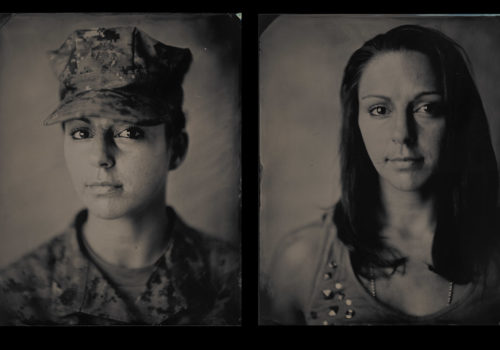Why did you decide to start this project ?
I began War and Peace during the anniversary year of September 11th as a way of reflecting on how this event impacted the nation and New York City. We have been a country at war in Iraq and Afghanistan for over twelve years now and many of the people I photographed for my project enlisted because of 9/11. We often talk about warfare in technological terms, but there is a human side to it. I wanted to create intimate portraits. And considering the origin of tintyping, it was also a unique opportunity to explore the rich history of the tintype and its beginnings documenting the Civil War in my modern portraits of the military.
How did you find your subjects?
Finding people was incredibly tough, but I never gave up and I think my persistence and drive really helped me to see this project through to completion. I began by calling, writing, and e-mailing five government branches, my local congressman, and also by visiting recruiting offices. Without having connections or contacts, this can be an impossible process. It wasn’t until I made contact with two marines, that things began to move forward. Also, the Coast Guard, the United States Navy, the United States Army, and the Wounded Warrior Project gave me their full support so that I could get access to the people I needed. So many people trusted me, without knowing me or about my work. I could not have told their story otherwise.
What do your portraits reveal about the service members you photographed?
Portraits that have power and meaning for me are ones that are honest and without artifice. Everyone who participated in this project sat before my camera without pretension or guise. A lot of trust was involved. Kirtan told me that while I took his photograph, he thought about what he saw during his deployment to Iraq and that some of that sadness is visible in his facial expression. Sarah’s femininity, tranquility, and toughness or Travis’s intellectual curiosity and focus are a real presence in their tintypes. There is definitely a story behind each portrait of love, loss, dreams, desires, sadness, and sacrifice, if you look long enough.
Was there a marked change in your subjects’ behavior when they were out of their uniform and in their own clothes?
I think the diptych format, contrasting the tintype of the person in uniform with the tintype in civilian clothes really encourages the viewer to study each portrait and draw their own conclusions. There was a sharpness of focus, intention, but also a softness and humanity to the portraits (both in and out of uniform). I think what struck me most was that this sense of calm, and humanness could co-exist with a real toughness in each person.
How long have you been working with tintypes?
I’ve been working professionally with tintypes for two years. One doesn’t just do a workshop and become proficient—it’s a process that takes trial and error, knowledge, and a serious commitment.
How long will these tintypes last and how does that influence your work?
Tintypes are fragile—their emulsions easily scratched or impressed. Metal oxidizes and decays, especially in a global environment with increasingly high levels of pollution. But in comparison with the evolution of color photography and digital printing, tintypes are inherently more stable and will outlast a c-print or a Polaroid or even a pigmented print for centuries to come. I like knowing that tintypes are unique, solitary images in a world that at times seems so disposable and casual. There is no negative, no copy, but only one portrait of its kind in the world! It becomes a relic or icon of the ones we love and treasure.
How did you know the project was complete?
The project was completed when my last subject, Anthony Bari, Jr., returned home to New York City. He was the first person who helped me and War and Peace would be inconceivable without him. Even though out of the country, Tony continued to work with me on the project—he always kept his word. I waited a year for him to return and somehow taking his portrait, the last portrait of the series, brought it to completion. The military and the war in Iraq and Afghanistan are huge subjects to visualize–War and Peace represents but one story, one perspective of something much larger than all of us.
What’s next for you? Is there a project you’re working on?
Presently, I am in the post-production stage of an exhibition, Skywalkers, on the Mohawk Ironworkers rebuilding the World Trade Center. I shot thirty tintype portraits of Mohawks from the Kanawake and Aquasasne reservations in Canada. These men represent four generations of ironworkers traveling from Canada to New York to build icons from the Empire State Building to the George Washington Bridge. Telling the story of Rebuilding is an important narrative to the post-911 landscape.
Sam Barzilay, United Photo Industries
Melissa Cacciola: War and Peace
April 7 – 27, 2013
United Photo Industries
111 Front Street, Suite 204
Brooklyn, NY, 11201
USA
















